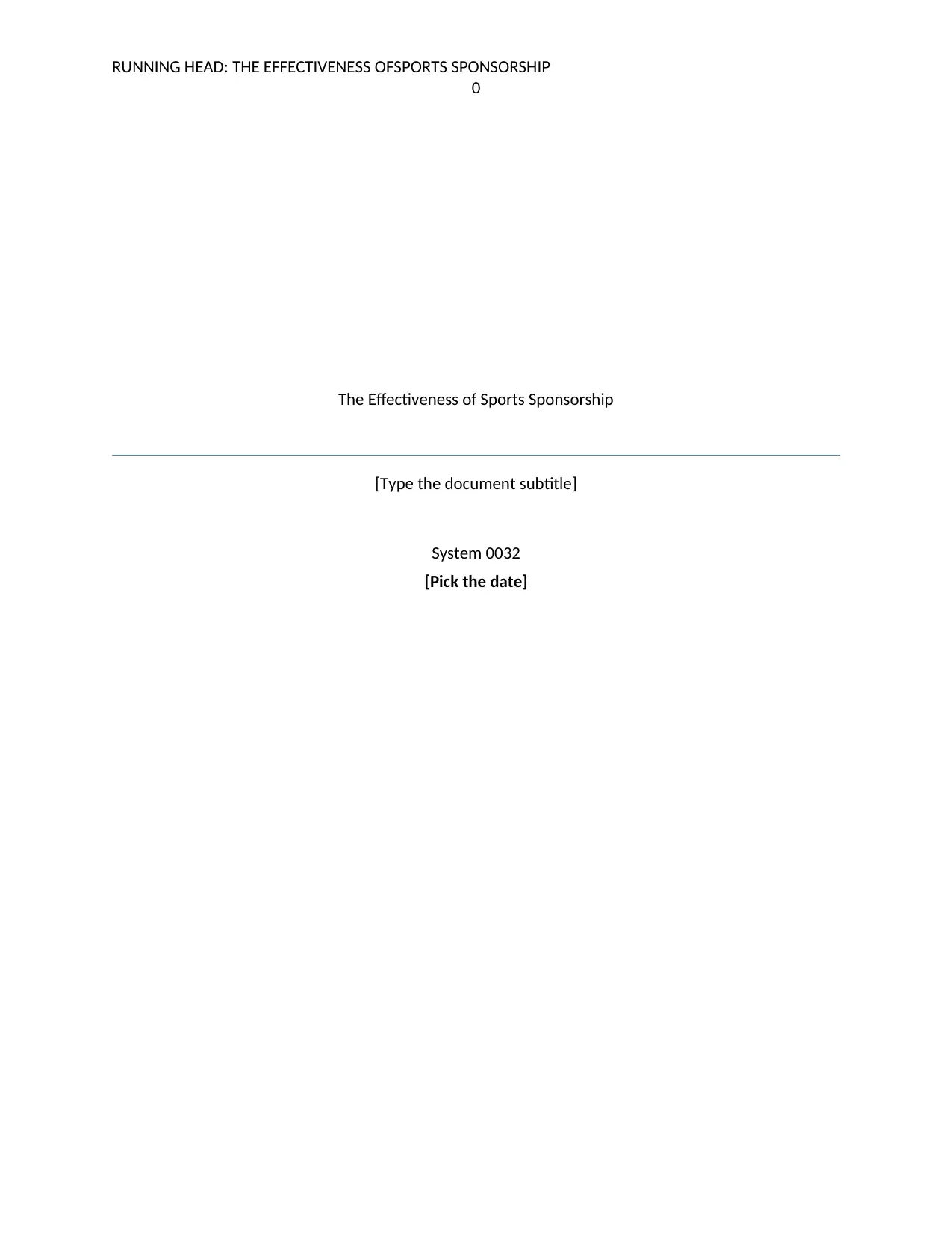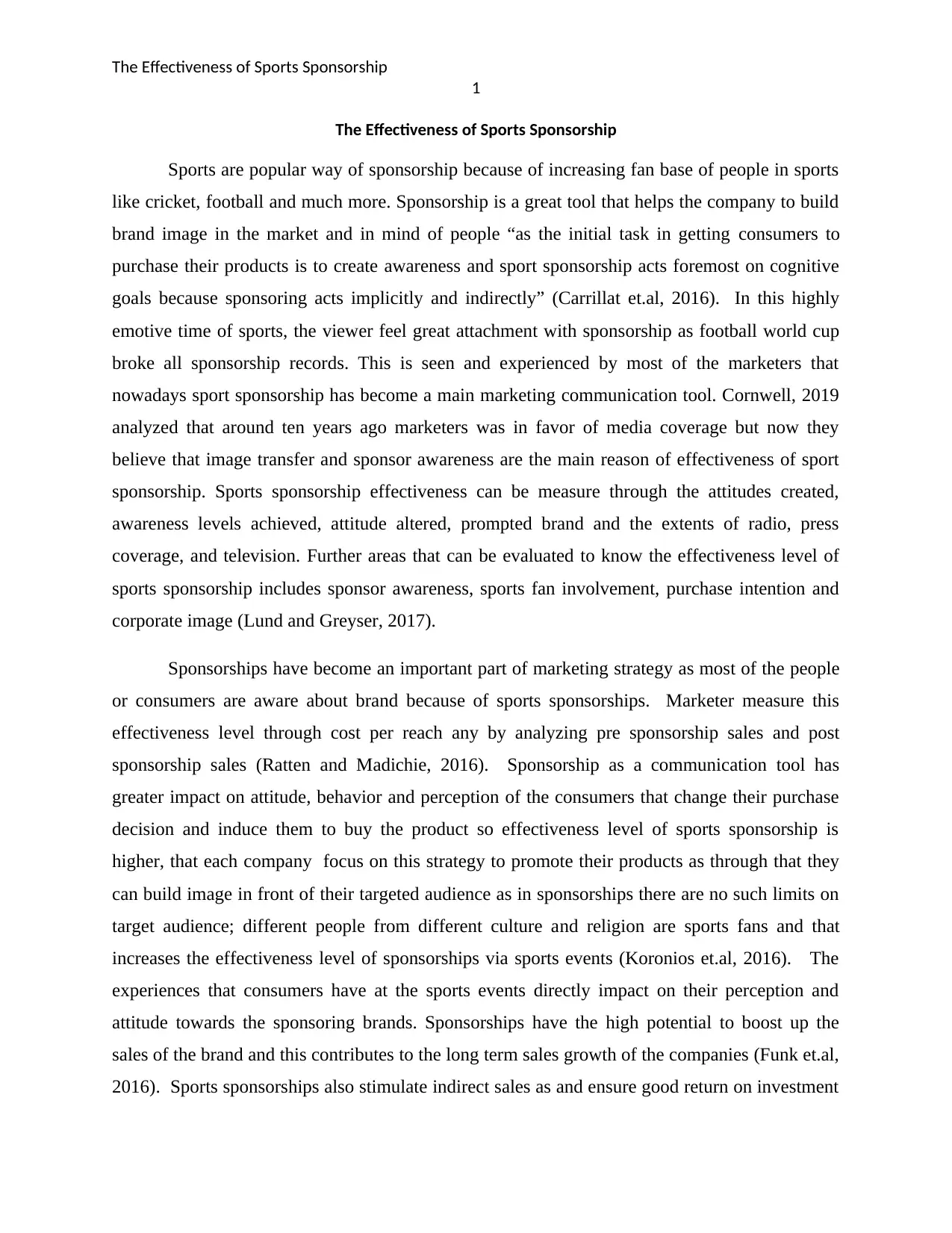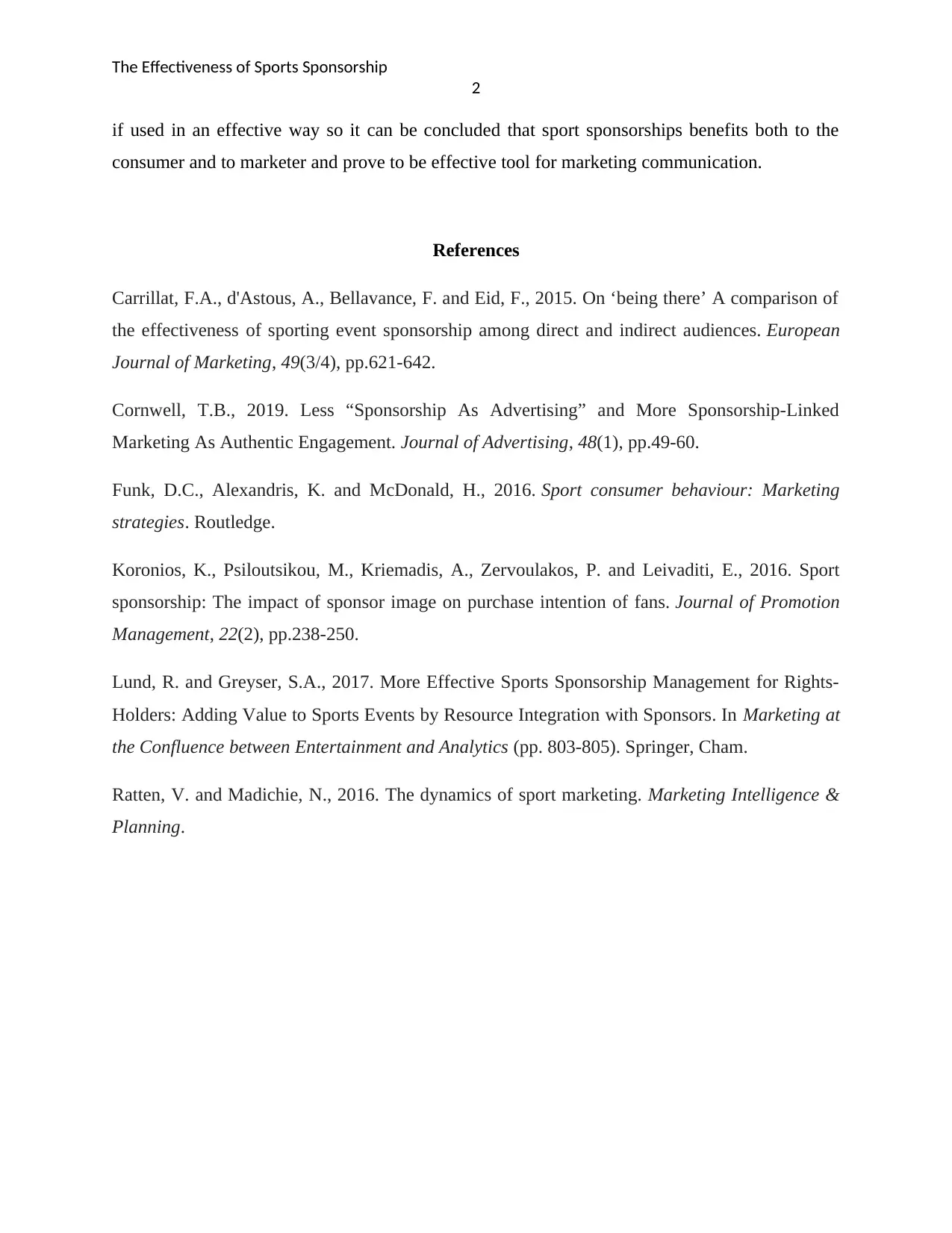Analyzing the Effectiveness of Sports Sponsorship in Marketing
VerifiedAdded on 2022/10/17
|3
|742
|19
Report
AI Summary
This report examines the effectiveness of sports sponsorship as a marketing communication tool. It highlights how sports sponsorships build brand image and increase brand awareness by leveraging the large and diverse fan base in sports like cricket and football. The report discusses how sponsorships influence consumer attitudes, behavior, and purchase decisions, ultimately boosting sales and long-term growth. It references several academic sources to support its claims, evaluating the effectiveness of sports sponsorship through metrics like cost per reach, pre and post-sponsorship sales, and consumer perception. The report concludes that sports sponsorships are beneficial for both consumers and marketers and are an effective tool for marketing communication.

RUNNING HEAD: THE EFFECTIVENESS OFSPORTS SPONSORSHIP
0
The Effectiveness of Sports Sponsorship
[Type the document subtitle]
System 0032
[Pick the date]
0
The Effectiveness of Sports Sponsorship
[Type the document subtitle]
System 0032
[Pick the date]
Paraphrase This Document
Need a fresh take? Get an instant paraphrase of this document with our AI Paraphraser

The Effectiveness of Sports Sponsorship
1
The Effectiveness of Sports Sponsorship
Sports are popular way of sponsorship because of increasing fan base of people in sports
like cricket, football and much more. Sponsorship is a great tool that helps the company to build
brand image in the market and in mind of people “as the initial task in getting consumers to
purchase their products is to create awareness and sport sponsorship acts foremost on cognitive
goals because sponsoring acts implicitly and indirectly” (Carrillat et.al, 2016). In this highly
emotive time of sports, the viewer feel great attachment with sponsorship as football world cup
broke all sponsorship records. This is seen and experienced by most of the marketers that
nowadays sport sponsorship has become a main marketing communication tool. Cornwell, 2019
analyzed that around ten years ago marketers was in favor of media coverage but now they
believe that image transfer and sponsor awareness are the main reason of effectiveness of sport
sponsorship. Sports sponsorship effectiveness can be measure through the attitudes created,
awareness levels achieved, attitude altered, prompted brand and the extents of radio, press
coverage, and television. Further areas that can be evaluated to know the effectiveness level of
sports sponsorship includes sponsor awareness, sports fan involvement, purchase intention and
corporate image (Lund and Greyser, 2017).
Sponsorships have become an important part of marketing strategy as most of the people
or consumers are aware about brand because of sports sponsorships. Marketer measure this
effectiveness level through cost per reach any by analyzing pre sponsorship sales and post
sponsorship sales (Ratten and Madichie, 2016). Sponsorship as a communication tool has
greater impact on attitude, behavior and perception of the consumers that change their purchase
decision and induce them to buy the product so effectiveness level of sports sponsorship is
higher, that each company focus on this strategy to promote their products as through that they
can build image in front of their targeted audience as in sponsorships there are no such limits on
target audience; different people from different culture and religion are sports fans and that
increases the effectiveness level of sponsorships via sports events (Koronios et.al, 2016). The
experiences that consumers have at the sports events directly impact on their perception and
attitude towards the sponsoring brands. Sponsorships have the high potential to boost up the
sales of the brand and this contributes to the long term sales growth of the companies (Funk et.al,
2016). Sports sponsorships also stimulate indirect sales as and ensure good return on investment
1
The Effectiveness of Sports Sponsorship
Sports are popular way of sponsorship because of increasing fan base of people in sports
like cricket, football and much more. Sponsorship is a great tool that helps the company to build
brand image in the market and in mind of people “as the initial task in getting consumers to
purchase their products is to create awareness and sport sponsorship acts foremost on cognitive
goals because sponsoring acts implicitly and indirectly” (Carrillat et.al, 2016). In this highly
emotive time of sports, the viewer feel great attachment with sponsorship as football world cup
broke all sponsorship records. This is seen and experienced by most of the marketers that
nowadays sport sponsorship has become a main marketing communication tool. Cornwell, 2019
analyzed that around ten years ago marketers was in favor of media coverage but now they
believe that image transfer and sponsor awareness are the main reason of effectiveness of sport
sponsorship. Sports sponsorship effectiveness can be measure through the attitudes created,
awareness levels achieved, attitude altered, prompted brand and the extents of radio, press
coverage, and television. Further areas that can be evaluated to know the effectiveness level of
sports sponsorship includes sponsor awareness, sports fan involvement, purchase intention and
corporate image (Lund and Greyser, 2017).
Sponsorships have become an important part of marketing strategy as most of the people
or consumers are aware about brand because of sports sponsorships. Marketer measure this
effectiveness level through cost per reach any by analyzing pre sponsorship sales and post
sponsorship sales (Ratten and Madichie, 2016). Sponsorship as a communication tool has
greater impact on attitude, behavior and perception of the consumers that change their purchase
decision and induce them to buy the product so effectiveness level of sports sponsorship is
higher, that each company focus on this strategy to promote their products as through that they
can build image in front of their targeted audience as in sponsorships there are no such limits on
target audience; different people from different culture and religion are sports fans and that
increases the effectiveness level of sponsorships via sports events (Koronios et.al, 2016). The
experiences that consumers have at the sports events directly impact on their perception and
attitude towards the sponsoring brands. Sponsorships have the high potential to boost up the
sales of the brand and this contributes to the long term sales growth of the companies (Funk et.al,
2016). Sports sponsorships also stimulate indirect sales as and ensure good return on investment

The Effectiveness of Sports Sponsorship
2
if used in an effective way so it can be concluded that sport sponsorships benefits both to the
consumer and to marketer and prove to be effective tool for marketing communication.
References
Carrillat, F.A., d'Astous, A., Bellavance, F. and Eid, F., 2015. On ‘being there’ A comparison of
the effectiveness of sporting event sponsorship among direct and indirect audiences. European
Journal of Marketing, 49(3/4), pp.621-642.
Cornwell, T.B., 2019. Less “Sponsorship As Advertising” and More Sponsorship-Linked
Marketing As Authentic Engagement. Journal of Advertising, 48(1), pp.49-60.
Funk, D.C., Alexandris, K. and McDonald, H., 2016. Sport consumer behaviour: Marketing
strategies. Routledge.
Koronios, K., Psiloutsikou, M., Kriemadis, A., Zervoulakos, P. and Leivaditi, E., 2016. Sport
sponsorship: The impact of sponsor image on purchase intention of fans. Journal of Promotion
Management, 22(2), pp.238-250.
Lund, R. and Greyser, S.A., 2017. More Effective Sports Sponsorship Management for Rights-
Holders: Adding Value to Sports Events by Resource Integration with Sponsors. In Marketing at
the Confluence between Entertainment and Analytics (pp. 803-805). Springer, Cham.
Ratten, V. and Madichie, N., 2016. The dynamics of sport marketing. Marketing Intelligence &
Planning.
2
if used in an effective way so it can be concluded that sport sponsorships benefits both to the
consumer and to marketer and prove to be effective tool for marketing communication.
References
Carrillat, F.A., d'Astous, A., Bellavance, F. and Eid, F., 2015. On ‘being there’ A comparison of
the effectiveness of sporting event sponsorship among direct and indirect audiences. European
Journal of Marketing, 49(3/4), pp.621-642.
Cornwell, T.B., 2019. Less “Sponsorship As Advertising” and More Sponsorship-Linked
Marketing As Authentic Engagement. Journal of Advertising, 48(1), pp.49-60.
Funk, D.C., Alexandris, K. and McDonald, H., 2016. Sport consumer behaviour: Marketing
strategies. Routledge.
Koronios, K., Psiloutsikou, M., Kriemadis, A., Zervoulakos, P. and Leivaditi, E., 2016. Sport
sponsorship: The impact of sponsor image on purchase intention of fans. Journal of Promotion
Management, 22(2), pp.238-250.
Lund, R. and Greyser, S.A., 2017. More Effective Sports Sponsorship Management for Rights-
Holders: Adding Value to Sports Events by Resource Integration with Sponsors. In Marketing at
the Confluence between Entertainment and Analytics (pp. 803-805). Springer, Cham.
Ratten, V. and Madichie, N., 2016. The dynamics of sport marketing. Marketing Intelligence &
Planning.
⊘ This is a preview!⊘
Do you want full access?
Subscribe today to unlock all pages.

Trusted by 1+ million students worldwide
1 out of 3
Related Documents
Your All-in-One AI-Powered Toolkit for Academic Success.
+13062052269
info@desklib.com
Available 24*7 on WhatsApp / Email
![[object Object]](/_next/static/media/star-bottom.7253800d.svg)
Unlock your academic potential
Copyright © 2020–2025 A2Z Services. All Rights Reserved. Developed and managed by ZUCOL.




